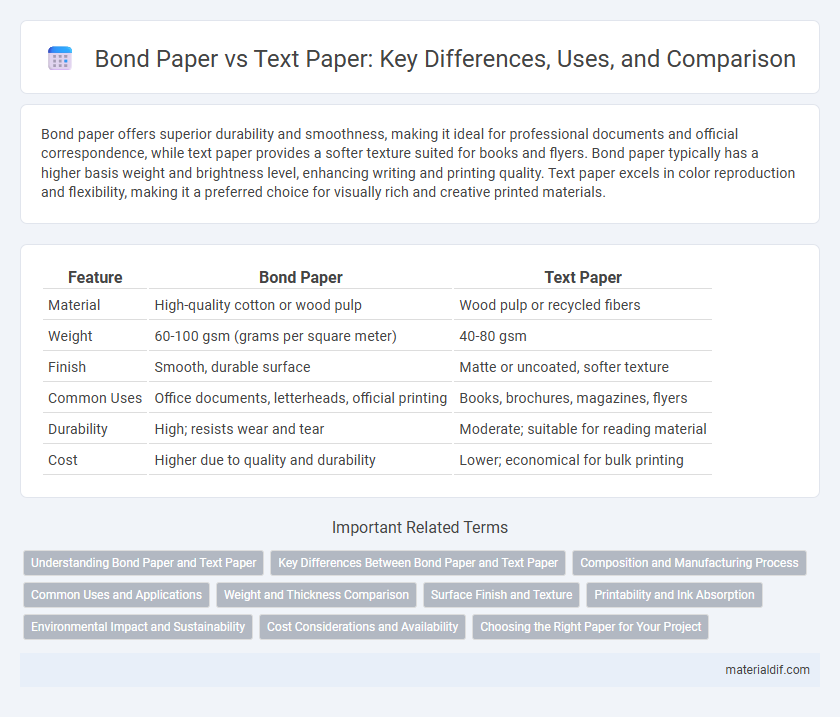Bond paper offers superior durability and smoothness, making it ideal for professional documents and official correspondence, while text paper provides a softer texture suited for books and flyers. Bond paper typically has a higher basis weight and brightness level, enhancing writing and printing quality. Text paper excels in color reproduction and flexibility, making it a preferred choice for visually rich and creative printed materials.
Table of Comparison
| Feature | Bond Paper | Text Paper |
|---|---|---|
| Material | High-quality cotton or wood pulp | Wood pulp or recycled fibers |
| Weight | 60-100 gsm (grams per square meter) | 40-80 gsm |
| Finish | Smooth, durable surface | Matte or uncoated, softer texture |
| Common Uses | Office documents, letterheads, official printing | Books, brochures, magazines, flyers |
| Durability | High; resists wear and tear | Moderate; suitable for reading material |
| Cost | Higher due to quality and durability | Lower; economical for bulk printing |
Understanding Bond Paper and Text Paper
Bond paper is a high-quality, durable writing paper commonly used for official documents, letterheads, and stationery due to its weight range of 16 to 36 pounds and smooth finish. Text paper, also known as offset or book paper, features a lighter weight between 50 to 100 gsm and is designed for printing books, brochures, and magazines with good opacity and brightness. Understanding the distinct properties of bond and text paper helps in selecting the right paper type for specific printing and writing needs, ensuring both functionality and aesthetic appeal.
Key Differences Between Bond Paper and Text Paper
Bond paper features a durable, thicker texture often used for official documents and letterheads, while text paper is thinner and smoother, ideal for books, newspapers, and brochures. Bond paper typically has a higher weight, generally ranging from 16 to 36 pounds, offering better opacity and print quality compared to text paper's lighter weight of 50 to 80 gsm. The manufacturing process of bond paper emphasizes strength and longevity, contrasting with text paper's focus on flexibility and smoothness for high-quality color printing.
Composition and Manufacturing Process
Bond paper is composed primarily of wood pulp with a higher cotton content, resulting in increased strength and durability, while text paper is made from a blend of wood fibers designed for smoothness and print quality. The manufacturing process of bond paper involves longer fiber processing and calendaring to enhance its rigidity and resistance to wear, whereas text paper undergoes finer refining and coating to achieve a glossy and uniform surface ideal for detailed images. These compositional and process differences dictate bond paper's suitability for official documents and text paper's preference in high-quality printing applications.
Common Uses and Applications
Bond paper is commonly used for official documents, letterheads, and business correspondence due to its durability and professional appearance. Text paper is preferred for printing books, brochures, and flyers because of its lighter weight and smooth finish, which enhances readability and print quality. Both types serve distinct purposes in printing and publishing, optimizing function and aesthetics for specific applications.
Weight and Thickness Comparison
Bond paper typically ranges from 16 to 24 pounds in weight and has a thickness of approximately 0.16 to 0.19 millimeters, making it slightly heavier and thicker than text paper. Text paper usually weighs between 40 to 80 grams per square meter (gsm) with a thickness around 0.05 to 0.10 millimeters, offering a lighter and thinner option ideal for book printing and high-volume text content. The weight and thickness differences directly affect the paper's durability, opacity, and suitability for various printing purposes.
Surface Finish and Texture
Bond paper features a smooth surface finish ideal for high-quality printing and clear text reproduction, while text paper typically has a slightly textured surface that enhances tactile appeal and ink absorption for artistic prints. The surface finish of bond paper promotes sharp image clarity, whereas the texture of text paper creates a distinct, handcrafted feel suitable for invitations and letterheads. Selecting between bond and text paper depends on the desired aesthetic and functionality for professional or creative print projects.
Printability and Ink Absorption
Bond paper offers superior printability due to its smooth, durable surface that ensures sharp text and vibrant colors, making it ideal for professional documents. Text paper, characterized by a slightly rougher texture, provides enhanced ink absorption, resulting in deeper color saturation but potentially less precision in fine details. Choosing between bond and text paper depends on the balance needed between crisp print quality and rich ink absorption for specific printing projects.
Environmental Impact and Sustainability
Bond paper typically has a higher recycled fiber content and is often produced using chlorine-free bleaching processes, reducing its environmental footprint compared to traditional text paper. Text paper usually requires more intensive processing and chemical treatments, resulting in greater energy consumption and waste generation, which can negatively impact sustainability. Choosing bond paper for printing needs supports eco-friendly practices by minimizing deforestation and promoting the use of sustainable forestry resources.
Cost Considerations and Availability
Bond paper generally costs more than text paper due to its higher durability and quality, making it ideal for official documents and professional printing. Text paper is more widely available and budget-friendly, favored for bulk printing and everyday use such as flyers or brochures. Availability of bond paper can be limited in certain markets, whereas text paper is commonly stocked by most office and print suppliers.
Choosing the Right Paper for Your Project
Bond paper offers durability and a smooth finish, making it ideal for official documents and printing with crisp text clarity. Text paper features a textured surface and higher opacity, enhancing the visual appeal for brochures, invitations, and artistic projects. Selecting the right paper depends on the desired print quality, project purpose, and presentation style to achieve professional and effective results.
Bond Paper vs Text Paper Infographic

 materialdif.com
materialdif.com